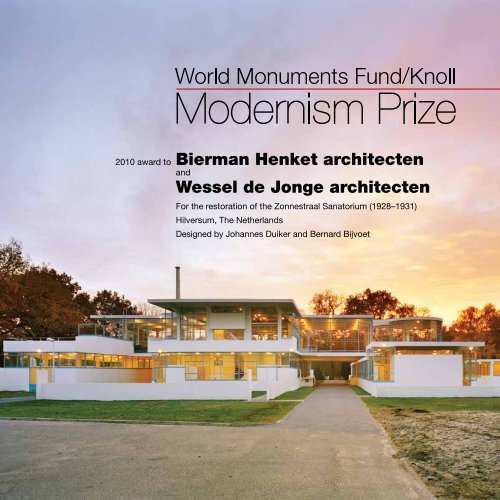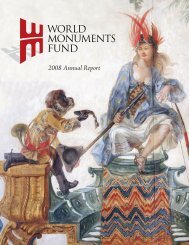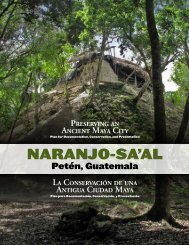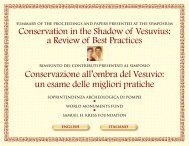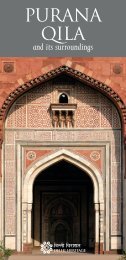Bierman Henket architecten Wessel de Jonge architecten - World ...
Bierman Henket architecten Wessel de Jonge architecten - World ...
Bierman Henket architecten Wessel de Jonge architecten - World ...
Create successful ePaper yourself
Turn your PDF publications into a flip-book with our unique Google optimized e-Paper software.
2010 award to<br />
<strong>Bierman</strong> <strong>Henket</strong> <strong>architecten</strong><br />
and<br />
<strong>Wessel</strong> <strong>de</strong> <strong>Jonge</strong> <strong>architecten</strong><br />
For the restoration of the Zonnestraal Sanatorium (1928–1931)<br />
Hilversum, The Netherlands<br />
Designed by Johannes Duiker and Bernard Bijvoet
2<br />
Zonnestraal is a mo<strong>de</strong>rn movement gem of concrete and glass, revelatory in<br />
its own time and a discovery anew each time architects and historians have<br />
rediscovered it after years of neglect. Now as <strong>Wessel</strong> <strong>de</strong> <strong>Jonge</strong>’s and Hubert-<br />
Jan <strong>Henket</strong>’s work on the restoration comes to a key stage of completion,<br />
it reconfirms without a doubt that Zonnestraal stands as one of the most<br />
experimental <strong>de</strong>signs in the fervently creative <strong>de</strong>ca<strong>de</strong>s of mo<strong>de</strong>rnism between<br />
the two world wars. A beacon of Dutch rationalism, it is also a major work of<br />
mo<strong>de</strong>rn architecture that can now be experienced in a way that resonates<br />
with its original architects’ intentions.<br />
—Jury Chairman Barry Bergdoll<br />
The Philip Johnson Chief Curator of Architecture and Design at The Museum of Mo<strong>de</strong>rn Art
4<br />
Since the founding of the <strong>World</strong> Monuments Fund Mo<strong>de</strong>rnism<br />
at Risk Initiative in 2006, we have encountered dozens of<br />
great buildings from the recent past that were on the brink of<br />
loss, and where architects and other advocates were struggling<br />
to save them. Lacking a watchful constituency or a clear future,<br />
mo<strong>de</strong>rn buildings disappear without a trace, often without a<strong>de</strong>quate<br />
public review. To save them requires imagination, <strong>de</strong>termination, and<br />
even a measure of heroism.<br />
The 2010 WMF/Knoll Mo<strong>de</strong>rnism Prize recognizes a prime example<br />
of this struggle. The Zonnestraal Sanitorium is an elegant functionalist<br />
work, but it was built to have a short life. Its original <strong>de</strong>sign was<br />
predicated on the belief that its purpose of harboring tuberculosis<br />
patients would soon be outdated by the invention of new cures for the<br />
disease. And it was, leaving the building with no use. But its reputation<br />
lived on among architects and historians, and a <strong>de</strong>termination grew to<br />
give it a new life, even as it approached the brink of loss. This prize<br />
salutes the outstanding work of architects Hubert-Jan <strong>Henket</strong> and<br />
<strong>Wessel</strong> <strong>de</strong> <strong>Jonge</strong>, for their innovative restoration of this mo<strong>de</strong>rnist gem.<br />
It should be noted that the risk of losing the Zonnestraal Sanitorium<br />
gave birth to a new organization—DOCOMOMO—now a worldwi<strong>de</strong><br />
network of professionals active in documenting important mo<strong>de</strong>rn<br />
structures in face of the prospect of their imminent loss. In awarding this<br />
prize, WMF also salutes their efforts.<br />
The WMF/Knoll Mo<strong>de</strong>rnism Prize is the only prize to acknowledge the<br />
specific and growing threats facing significant mo<strong>de</strong>rn buildings, and to<br />
recognize the architects and <strong>de</strong>signers who help ensure their rejuvenation<br />
and long-term survival through new <strong>de</strong>sign solutions. We hope the<br />
excellent work recognized by the awarding of this second biennial WMF/<br />
Knoll prize will inspire others to un<strong>de</strong>rtake the efforts that are nee<strong>de</strong>d to<br />
preserve these important buildings at risk, and will also stimulate more<br />
public vigilance for iconic buildings created in our own time. WMF is<br />
grateful to Knoll for this opportunity to draw attention to one of the most<br />
pressing issues of historic preservation today.<br />
Bonnie Burnham<br />
Presi<strong>de</strong>nt, <strong>World</strong> Monuments Fund
Throughout the history of our company, Knoll has fostered the<br />
most unique talents of our time, drawing on the creativity of<br />
architects and <strong>de</strong>signers worldwi<strong>de</strong> to connect people with<br />
their work, their lives and their world. The <strong>World</strong> Monuments<br />
Fund/Knoll Mo<strong>de</strong>rnism Prize reflects this mission by recognizing those<br />
who <strong>de</strong>monstrate that endangered mo<strong>de</strong>rn buildings can be economically<br />
and functionally viable, and continue to serve their communities,<br />
often in new and innovative ways.<br />
Our partnership with the <strong>World</strong> Monuments Fund is consistent with<br />
our commitment to preserve the integrity of landmark mid-century<br />
furniture <strong>de</strong>signs sold by Knoll and to manufacture these products<br />
according to the <strong>de</strong>signers’ original specifications.<br />
Knoll associates are proud that our work with the <strong>World</strong> Monuments<br />
Fund, including the exhibition Mo<strong>de</strong>rnism at Risk: Mo<strong>de</strong>rn Solutions for<br />
Saving Landmarks, has raised international awareness of <strong>de</strong>sign<br />
through education and advocacy in both the public and professional<br />
arenas. These important initiatives, which have captured the imagination<br />
of so many—stu<strong>de</strong>nts, <strong>de</strong>sign professionals, and community lea<strong>de</strong>rs—<br />
reinforce our belief in the timeless role that good <strong>de</strong>sign plays in <strong>de</strong>fining<br />
the pulse of contemporary life.<br />
andrew B. Cogan<br />
CEO, Knoll, Inc.<br />
5
6<br />
The <strong>World</strong> monumenTs Fund mo<strong>de</strong>rnism aT risk iniTiaTive was launched in 2006<br />
to bring international attention and resources to address the key threats and challenges facing many<br />
mo<strong>de</strong>rn buildings only <strong>de</strong>ca<strong>de</strong>s after their <strong>de</strong>sign and construction: <strong>de</strong>molition, inappropriate<br />
alteration, perceived obsolescence, and public apathy, as well as the technical problems associated<br />
with conserving innovative <strong>de</strong>signs and materials.<br />
The <strong>World</strong> monumenTs Fund/knoll mo<strong>de</strong>rnism Prize was established as part of<br />
the larger advocacy mission of the <strong>World</strong> Monuments Fund Mo<strong>de</strong>rnism at Risk Initiative to<br />
acknowledge the specific and growing threats—neglect, <strong>de</strong>terioration, and <strong>de</strong>molition—facing<br />
significant mo<strong>de</strong>rn buildings, and to recognize the architects and <strong>de</strong>signers who help ensure their<br />
rejuvenation and long-term survival through new <strong>de</strong>sign solutions. The prize is awar<strong>de</strong>d biennially to<br />
an individual or firm in recognition of a completed project or a body of work. The award is a $10,000<br />
honorarium and a limited-edition chair manufactured by Knoll.<br />
Knoll is the founding sponsor of the <strong>World</strong> Monuments Fund Mo<strong>de</strong>rnism at Risk Initiative and<br />
the <strong>World</strong> Monuments Fund/Knoll Mo<strong>de</strong>rnism Prize.<br />
<strong>World</strong> monumenTs Fund is the leading in<strong>de</strong>pen<strong>de</strong>nt organization <strong>de</strong>voted to saving the<br />
world’s treasured places. For 45 years, working in more than 90 countries, our highly skilled experts<br />
have applied proven and effective techniques to preserve important architectural and cultural<br />
heritage sites around the globe. Through partnerships with local communities, fun<strong>de</strong>rs, and<br />
governments, WMF inspires an enduring commitment to stewardship for future generations.<br />
Headquartered in New York, WMF has offices and affiliates worldwi<strong>de</strong>.
One of Zonnestraal’s restored workrooms<br />
7
Caregivers 8 at Zonnestraal, ca. 1935<br />
The Jury<br />
Barry Bergdoll<br />
The Philip Johnson Chief Curator<br />
of Architecture and Design,<br />
The Museum of Mo<strong>de</strong>rn Art, New York, NY<br />
Jean-louis Cohen<br />
Sheldon H. Solow Professor<br />
in the History of Architecture,<br />
Institute of Fine Arts, New York University,<br />
New York, NY<br />
kenneTh FramPTon<br />
Ware Professor of Architecture,<br />
Graduate School of Architecture,<br />
Planning and Preservation,<br />
Columbia University, New York, NY<br />
dieTriCh neumann<br />
Professor, Department of History<br />
of Art and Architecture, Brown University,<br />
Provi<strong>de</strong>nce, RI<br />
Theo Prudon<br />
Presi<strong>de</strong>nt of DOCOMOMO US<br />
and Adjunct Associate Professor of Historic<br />
Preservation at Columbia University,<br />
New York, NY<br />
karen sTein<br />
Design consultant, writer, and faculty<br />
member in the Design Criticism<br />
program at the School of Visual Arts,<br />
New York, NY
Zonnestraal, Dresselhuys Pavilion (1931),<br />
before and after restoration<br />
9
10<br />
zonnesTraal sanaTorium was <strong>de</strong>signed between 1925 and 1927 by Jan Duiker (1890–<br />
1935), the leading spokesman for the mo<strong>de</strong>rn movement in the Netherlands, Bernard Bijvoet<br />
(1889–1979), and structural engineer Jan Gerko Wiebenga (1886–1974). Completed in 1931, the<br />
sanatorium functioned as a rehabilitation center for tuberculosis patients and was <strong>de</strong>signed with<br />
the conviction that a cure for the <strong>de</strong>adly disease would be discovered within thirty to fifty years.<br />
Embracing the progressive i<strong>de</strong>als of the mo<strong>de</strong>rn movement, Zonnestraal’s architecture sought<br />
short-term functionality, providing the requisite lighting and ventilation that specialists postulated<br />
was necessary to treat the illness.<br />
Zonnestraal was celebrated as a significant monument in the early years of the mo<strong>de</strong>rn<br />
movement even while it was un<strong>de</strong>r construction. The <strong>de</strong>ath of Duiker in 1935 and progress in the<br />
eradication of tuberculosis following the Second <strong>World</strong> War, however, saw the sanatorium soon<br />
fa<strong>de</strong> from public and aca<strong>de</strong>mic notice, falling into disuse and disrepair, with sections almost literally<br />
disappearing into the surrounding landscape. For nearly two <strong>de</strong>ca<strong>de</strong>s, Zonnestraal was forgotten.<br />
In the 1960s, however, the sanatorium was rediscovered and <strong>de</strong>emed by architectural historians<br />
to be a major monument of mo<strong>de</strong>rn architecture. In 1982, faced with the looming physical <strong>de</strong>cline<br />
and programmatic obsolescence of a growing body of mo<strong>de</strong>rn architecture in The Netherlands,<br />
the Dutch government convened leading architects, hea<strong>de</strong>d by Hubert-Jan <strong>Henket</strong> and <strong>Wessel</strong> <strong>de</strong><br />
<strong>Jonge</strong>, to address this problem. Zonnestraal was the monumental iconic example used as the<br />
template for the study on how to save mo<strong>de</strong>rn buildings. Completed in 1987, the study led not only<br />
to a conservation program for Zonnestraal, but to the eventual creation (in 1988) of an international<br />
movement to save great works of mo<strong>de</strong>rn architecture: DOCOMOMO. Zonnestraal’s physical<br />
survival was assured when it received landmark protection in 1995.<br />
Over the last 15 years, exhaustive research and painstaking conservation and reconstruction by<br />
Messrs. <strong>Henket</strong> and <strong>Wessel</strong> <strong>de</strong> <strong>Jonge</strong> have seen the sanatorium restored to its original splendor<br />
and re-purposed for contemporary use. Zonnestraal now serves as a multi-purpose health facility,<br />
accommodating several health care provi<strong>de</strong>rs, an obesity clinic, a sports injury rehabilitation clinic,<br />
and a conference center.<br />
The conservation effort to save the sanatorium is both immediate and long-term, site specific<br />
and global. Nearly eighty years after its original date of completion, the architects’ commitment to<br />
restoring the complex architecture and reviving its purpose furthers the legacy of Zonnestraal as an<br />
icon of the mo<strong>de</strong>rn movement.
Zonnestraal , 1931<br />
11
12<br />
Hubert-Jan <strong>Henket</strong> (left) and <strong>Wessel</strong> <strong>de</strong> <strong>Jonge</strong><br />
<strong>Bierman</strong> henket <strong>architecten</strong><br />
Architecture is utilitarian art, representing the spatial <strong>de</strong>sign of social structures. The primary aim<br />
of these structural processes is to satisfy human <strong>de</strong>mands and embody their dreams.<br />
<strong>Bierman</strong> <strong>Henket</strong> <strong>architecten</strong> is a medium-sized architectural firm with a staff of highly trained<br />
architects, <strong>de</strong>signers, and planners. Their expertise in the field is extensive, and their skill sets<br />
wi<strong>de</strong>-ranging. The office is organized as a <strong>de</strong>sign studio, where a <strong>de</strong>sign team for each project is<br />
assembled. As necessary, external advisors are inclu<strong>de</strong>d.<br />
<strong>Wessel</strong> <strong>de</strong> <strong>Jonge</strong> <strong>architecten</strong><br />
In revitalization, the restrictions imposed by the existing building pose an inspiring challenge. Our<br />
goal is to ensure that a building is able to speak for itself again.<br />
<strong>Wessel</strong> <strong>de</strong> <strong>Jonge</strong> <strong>architecten</strong> is a growing firm with a strong and expanding portfolio of projects,<br />
recognized internationally for its work in the reuse and restoration of architectural heritage of the<br />
recent past, often in a dynamic urban context. In an architecture that is lucid and subtle, with<br />
sophisticated choices of materials and <strong>de</strong>tails, spaces are created where the occupants feel<br />
comfortable and at ease.
Mo<strong>de</strong>rnist buildings are <strong>de</strong>signed with temporality in mind, which makes<br />
them often fragile and very hard to preserve for future generations.<br />
That’s why I am so thrilled we won this important prize with Zonnestraal,<br />
the most fragile and most inspiring of them all.<br />
—huBerT-Jan henkeT, oF <strong>Bierman</strong> henkeT arChiTeCTen<br />
The careful dismantling of the main building proved an unprece<strong>de</strong>nted<br />
source of knowledge and hands-on experience with early mo<strong>de</strong>rn<br />
building technology and its preservation…the great value of Duiker’s<br />
work is now again attainable to the expert community as well as the<br />
public at large. The fact that Zonnestraal is not only an architectural icon,<br />
but also a social landmark, gives this restoration an extra dimension and<br />
value to our social history.<br />
—<strong>Wessel</strong> <strong>de</strong> <strong>Jonge</strong>, oF <strong>Wessel</strong> <strong>de</strong> <strong>Jonge</strong> arChiTeCTen<br />
13
In awarding the 2010 <strong>World</strong> Monuments Fund/Knoll Mo<strong>de</strong>rnism Prize to <strong>Bierman</strong> <strong>Henket</strong> <strong>architecten</strong><br />
and <strong>Wessel</strong> De <strong>Jonge</strong> <strong>architecten</strong> for the restoration of Zonnestraal Sanatorium, the jury<br />
recognizes the formidable functional, material, and economic challenges that have threatened<br />
this site, and the architects’ heroic efforts in helping to forge a successful conservation plan that<br />
preserved the original <strong>de</strong>sign intent of the building, while updating it to meet mo<strong>de</strong>rn uses, mo<strong>de</strong>rn<br />
materials, and environmental standards. In addition to Jury Chairman Barry Bergdoll’s commendation<br />
that the <strong>Henket</strong> and <strong>de</strong> <strong>Jonge</strong> restoration has confirmed Zonnestraal’s standing in the canon<br />
of major works of mo<strong>de</strong>rn architecture internationally, other jurors spoke of the additional virtues of<br />
the conservation program.<br />
exCellenCe oF TeChniCal ConservaTion soluTions<br />
Theo Prudon praised the project’s “sound conservation philosophy and brilliant technical<br />
solutions to some of the most pressing challenges facing a building of such poetic lightness, which<br />
was constructed with minimal use of three materials: concrete, steel, and glass. The technical<br />
solutions for the building’s distinctive glass fenestration were especially thoughtful, incorporating<br />
sound scholarly research in original materials and programmatic and <strong>de</strong>sign intent with mo<strong>de</strong>rn<br />
advances in glass fabrications and environmental conservation.”<br />
CommuniTy engagemenT<br />
kenneth Frampton ad<strong>de</strong>d, “the restoration program for Zonnestraal re-engaged the community<br />
at all levels of Dutch society—governmental, professional, and local citizens—and returned the<br />
building to a programmatically and financially sustainable use as part of a health care facility. It is a use<br />
that is both respectful of its history and provi<strong>de</strong>s it with a vital and viable role in contemporary society.”
sCholarshiP<br />
As with the 2008 prize, the 2010 prize, according to Jean-louis Cohen, “recognizes practitioners<br />
engaged with intellectual issues, who do not consi<strong>de</strong>r their contribution solely a technical one. The<br />
thorough investigation of the archival sources and the <strong>de</strong>tailed material history of the building’s<br />
construction and use do not exclu<strong>de</strong> the invention of legitimate solutions for the conservation of<br />
<strong>de</strong>licate components. The combination of skills displayed at Zonnestraal reveals the kind of<br />
expertise mo<strong>de</strong>rn landmarks require.”<br />
QualiTy oF The resToraTion<br />
<strong>de</strong>itrich neumann stated his belief that “this careful restoration does full justice to the subtleties<br />
of the original building, its particular handling of light, and the seeming weightlessness of its<br />
composition. In this project, practical conservation and thorough scholarship reinforced each other<br />
in finding the best approach to the preservation of one of mo<strong>de</strong>rn architecture’s most important<br />
buildings.”<br />
reFerenCe For FuTure<br />
karen stein ad<strong>de</strong>d, “ the rallying of many great architectural minds to save Zonnestraal eventually<br />
led to the creation of DOCOMOMO. That legacy, plus the conservation solutions that were<br />
eventually implemented by <strong>Wessel</strong> <strong>de</strong> <strong>Jonge</strong> and Hubert-Jan <strong>Henket</strong>, will earn Zonnestraal its own<br />
chapter in any reference book on the preservation of mo<strong>de</strong>rn buildings.”<br />
Photos: Cover, pages 2, 3, 4, 5: michel<br />
kievits/sybolt voeten. Page 6: Raoul<br />
Suermondt. Page 8: Photo courtesy of<br />
the Van Nelle Historical Archives,<br />
Utrecht. Page 9: top, Rudolf Wielinga;<br />
bottom, Jannes Lin<strong>de</strong>rs. Page 11:<br />
Photo courtesy of the Van Nelle<br />
Historical Archives, Utrecht. Page 12:<br />
WMF. Page 14: WMF. 15, back cover:<br />
michel kievits/sybolt voeten.<br />
15
16<br />
350 Fifth Avenue, Suite 2412<br />
New York, NY 10118<br />
www.wmf.org


